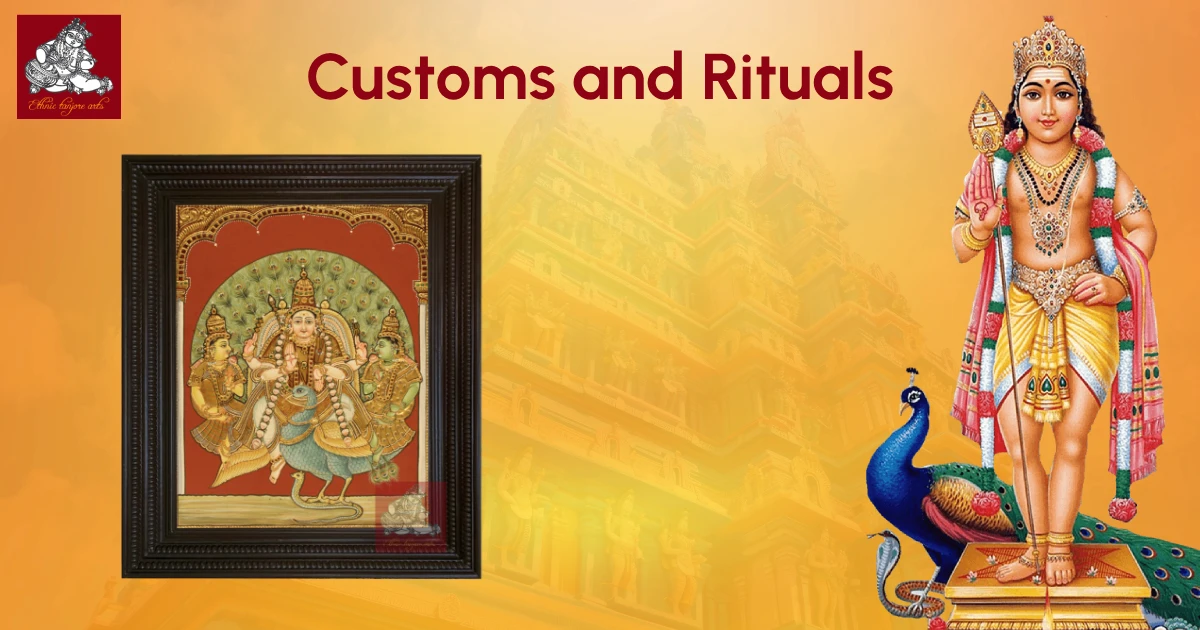Thaipusam: A Celebration of Faith, Devotion, and Triumph
Sep 11, 2024
On this auspicious day of Thaipusam, evil was trampled and peace was restored by the feisty son of Lord Shiva. It is also the day when devotees walk with scarred feet and bloodied cheeks, lift the Kavadi on their shoulders, and dance to the beats of drums in the name of Skanda to cleanse their souls of evil.
Thaipusam marks the day Lord Murugan slayed the asuran, Surapadman, and established dharma over the reigns of evil. Falling on the first full moon day, on the Pusam star of the Tamil month Thai, Thaipusam is celebrated with grandeur by the people of South India, Singapore, and Malaysia.
Follow along to uncover the origins, significance, and great history of Thaipusam.
Origins of Thaipusam: The reign of Surapadman
The origins of Thaipusam trace back to the birth of the asuran, Surapadman, who was the son of the sage Kashyap and the Shakti, Maya. His younger brothers were the Asuras, Tarakasuran, and Singamugan.
As the legend goes, Surapadman performed deep penance for years to Lord Shiva to earn a boon from the Supreme Deity. Moved by his devotion, Lord Shiva appeared before the asura.
Surapadman asked for a boon of infinite strength and power, to which Lord Shiva happily complied.
“Surapdman shall live 108 yugas, rule 1008 kingdoms, and be undefeated even by the forces of Lord Vishnu.”
He could only be killed by the son of Lord Shiva, who at the time was in deep mourning of his consort Sati and refused to marry.
This boon made Surapadman indestructible, and thus he started the reign of terror. He invaded the three worlds along with his brothers and imprisoned the followers of Lord Vishnu. Lord Indra and Indrani fled to earth, while Indra’s son was captured by the asuran.
With his arrogance, Surapadman mistreated the devas and assigned lowly tasks for them to be performed in his captivity.
Efforts of the Devas to wake Lord Shiva
During this time, Lord Shiva was in deep meditation, and the devas dreaded the consequences of disturbing him. So, they approached the deity who resides in the depths of the ocean, the protector of the realms, Lord Vishnu.
Lord Vishnu proposed the idea of Kamadeva interfering with the Lord’s meditation and making him see Parvati, the daughter of King Himavan. Parvati was Sati Devi in her previous life and did severe penance as Parvati to marry Lord Shiva.
Kamadeva, along with his consort Rati, performed songs and dances to make Lord Shiva break his meditation. When their efforts failed, Kamadeva used his arrow of love and struck Lord Shiva.
Furious Lord Shiva opened his third eye and burned Kamadeva to ashes for interfering with his meditation. Not long after, with the effects of the love arrow, Lord Shiva recognized the penance of Parvati Devi and married her.
But in her anger and grief, Rati cursed Parvati Devi never to have a child in her womb.
Birth of the Six-Faced Skanda
But to kill Tarakasuran and Surapadman, a son of Shiva has to be born in this world. So, six sparks emanated from the third eye of Lord Shiva. Lord Vayu was asked by Lord Shiva to carry the sparks to the earth. Not able to withstand the heat, Lord Vayu transferred the sparks to Lord Agni. Even Lord Agni couldn’t handle the heat that arose from the sparks; he deposited the sparks in Ganges, who in turn deposited the sparks in Sarava Lake, also called the Saravana Poigai.
The sparks transformed into six babies on lotus flowers and were raised by Six Kritikas, the stars of the constellation Pleiades. Hence Lord Murugan is also called Kartikeya, son of Kritika.
It was when Maa Parvati heard about them and hugged them that six babies fused together into Lord Murugan.
Lord Murugan is also known by different names: Skanda, Subramaniya, Shanmukha, Kumara, and Velan.
Significance of Thaipusam
With Lord Murugan as the commander-in-chief of the Devas army, the Devas attacked the Asura clan. With his vel, Lord Murugan first slayed the asuran Tarakasuran and Singamugan.
In a long battle of six days, Surapadman and Lord Murugan engaged in a fiery battle. With the magic powers granted to him, Surapadman took various forms and evaded Lord Murugan.
But on the sixth day of the battle, he transformed into a mango tree as a disguise to escape Skanda. But with the Vel, gifted to him by his mother Parvati, Lord Murugan tore the mango tree into two halves.
It is said one half transformed into a peacock, which Lord Murugan claimed as his vahana. The other half became the Rooster flag that Lord Muruga carries.
After the slaying of the asuran, Lord Murugan came to Thriuchendur to offer his prayers and thanks to his father, Lord Shiva. For this, he summoned the divine architect Mayan, and that’s how the Subramaniya Swamy Temple, Tiruchendur, came into existence.
Beyond the death of Surapadman, Thaipusam marks the day of triumph of goodness over evil, a day of strength, victory, celebration, and letting go of the evil burden in us.
Customs and Rituals

To prepare for the auspicious day of Thaipusam, devotees start by cleaning their homes and taking up fasting.
Devotees adorn in yellow and orange-colored garments, as they are the favorite color of Lord Murugan.
Then comes the heart of the celebration, with Kavadi aatam. Devotees carry a Kavadi, an arch-shaped ornament, with a wooden frame decorated with peacock feathers, flowers, and photos of Lord Murugan.
Other rituals include piercing the Vel in tongues, cheeks, or body as a practice of mortification of flesh to cleanse the sins.
Furthermore, dovotees carry a pot of milk as an offering to the deity.
Some people also take long pilgrimages on foot to primary Murugan temples like Thiruparankundram, Tiruchendur, Palani, Swamimalai, Thiruthani, and Pazhamudircholai.
Then, mantras are sung, prayers are performed, and sweets are distributed as offerings.
Thaipusam Around the World
Thaipusam is celebrated with grandeur, primarily among the Tamil population in South India, Malaysia, and Singapore.
Special prayers are performed at the Arupadai Veedugal and other Murugan temples in Tamil Nadu, with millions of devotees gathering.
In Malaysia, Thaipusam is an official holiday in several states. Devotees visit the Batu caves in Kuala Lumpur along with a procession of drums.
Similarly, in Singapore, devotees take a journey from Sri Perumal Temple along Serangoon Road in Little India, then make their way down a four-kilometer route to Sri Thendayuthapani Temple.
Takeaway
Born of a heavenly spark, Lord Murugan is the son of almighty Shiva and graceful Maa Parvati. Thaipusam marks the auspicious day of Lord Murugan slaying the asuran, Surapadman, and establishing peace again in the Three Worlds. On this holy day, Maa Parvati presented the Vel, infused with her shakthi, to Lord Murugan to kill the asuran.
The story of Lord Murugan's triumph resonates deeply in Tamil culture and is immortalized through various art forms, including the traditional Tanjore paintings.
Whether you seek Lord Murugan's blessings of strength, determination, or peace, a beautifully crafted Tanjore painting can serve as a constant reminder of his divine presence and protection in your home.
Explore our collection of Tanjore paintings, beautifully depicting Lord Murugan and his sacred story from Ethnic Tanjore Arts.
Shop Now for Tanjore Paintings!

